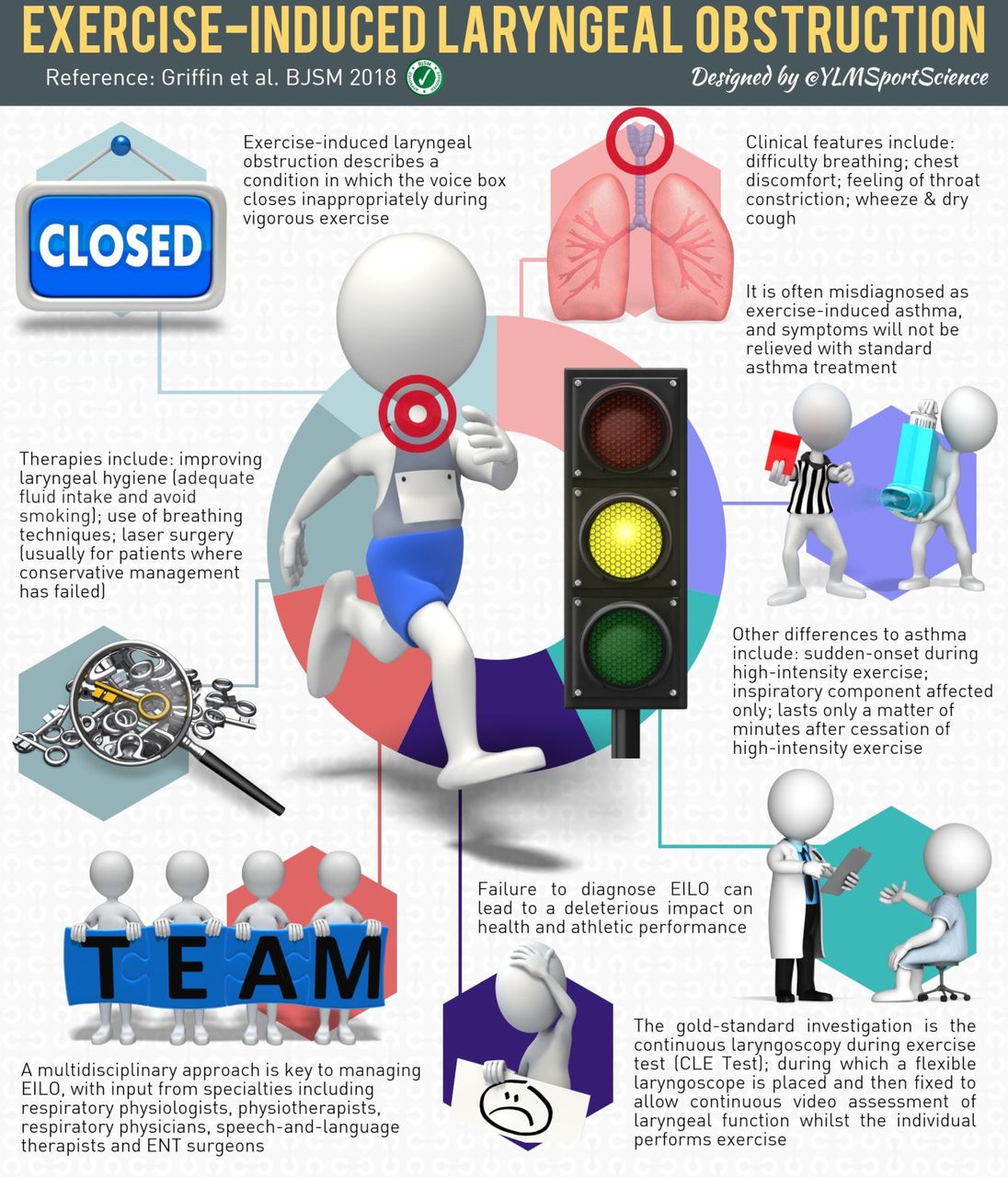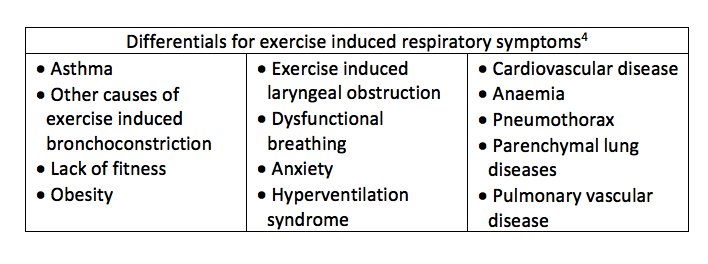Undergraduate perspective on Sport & Exercise Medicine – a BJSM blog series
By Katie Marino @krmarino1

Sports and exercise medicine (SEM) is a broad speciality that overlaps a number of different areas. Perhaps one of the more overlooked aspects of SEM is cardio-respiratory physiology and the vital role it has on performance. To gain more knowledge in this area I was fortunate enough to organise a 2-week placement with Dr. James Hull at the Royal Brompton Hospital in London. Dr. Hull is a Consultant Respiratory Physician who specialises in assessing athletes with unexplained breathlessness. Two key learning points from my placement will be discussed in this blog:
- the condition of Exercise Induced Laryngeal Obstruction (EILO) is an important differential for exercise associated wheeze.
- the different tests used to diagnose asthma and EILO.
Not all exercise induced wheeze is asthma
All clinicians, particularly those working with athletes, should be prepared to encounter patients with exercise related breathing complaints. Asthma is a common and well-established cause of exercise induced bronchoconstriction (EIB). Despite guidelines outlining the use of using objective tests to aid diagnosis, studies suggest that asthma is often diagnosed based on symptoms alone.1-3 Not using objective tests to confirm the diagnosis can lead to other conditions being incorrectly diagnosed as asthma, which can lead to patients being unnecessary medication, resulting in a waste of resources to the NHS and cost to the patient in prescription charges.
While there are many causes of exercise induced breathing symptoms (Table 14) I am going to focus on one of the most interesting conditions I learnt about during this placement: ‘Exercise Induced Laryngeal Obstruction’ (EILO). EILO is a narrowing of the larynx during intense exercise, typically secondary to abnormal adduction of the supraglottic or arytenoid structures (Nawia 2015). The underlying cause of this condition is unknown. The clinical features of EILO are a monophonic inspiratory wheeze, stridor, dyspnoea, cough, throat/chest tightness and dysphonia.5 There is limited evidence in the treatment of EILO, but most patients seem to benefit from individualised education into avoidance of laryngeal irritations and improved laryngeal hygiene, physiotherapy and speech and language therapy.


Table 25 gives an overview of the differences between EILO and exercise induced bronchoconstriction caused by asthma. However, there is probably much overlap between the presence of EIB and EILO.6 It is worth bearing in mind that if a patient isn’t responding to asthma medication as well as expected, they may have EILO as well as asthma and require treatment for both.
How to investigate?
During my placement I spent time with Dr. John Dickinson, an Exercise Respiratory Physiologists who has tested over 1,000 elite athletes, at the Centre of Health and Human Performance on Harley Street in London. I watched a Eucapnic Voluntary Hyperpnoea (EVH) test be performed at the centre, which is considered the gold-standard test for diagnosing exercise induced bronchoconstriction (EIB). During a EVH test, the patient breathes a cold, dry gas similar to normal air but with more carbon dioxide, for 6 minutes at a high ventilation rate. During this test a drop in the post-test FEV1 of 10% or more compared to baseline is considered a positive diagnosis of EIA. It determines if EIB is present and used to quantify the severity of the disorder (click here to see a short clip of a EVH test being performed https://www.youtube.com/watch?v=CAXvPKwUc_c). EILO is diagnosed using Continuous Laryngoscopy during Exercise (CLE) (Figure 1). CLE involves passing a laryngoscope through the nose to allow continuous observations of laryngeal structures during exercise and is the gold standard test for diagnosing EILO.

Figure 1: http://thorax.bmj.com/content/70/1/95
While asthma is a common cause of exercise induced shortness of breath and wheeze, other diagnosis should be considered and may be occurring alongside asthma. Encouraging people to be active is vital and if respiratory conditions stop patients from exercising, we need to take a proactive approach to treating them, and this may include not giving inhalers to everyone that comes in with a wheeze.
Take home points
- Not all exercise related wheeze is asthma.
- It is important to clarify more about what they mean by ‘wheeze’. For example, is it inspiratory or expiratory.
- EILO is an important cause of exercise induced respiratory symptoms in young athletes, the symptoms of which are often confused with asthma.
Respiratory health in athletes: facing the COVID-19 challenge with Dr James Hull. Episode #428
Katie Marino @krmarino1 is a final year medical student (Sheffield University). SEM Msc (Nottingham University). Student Representative on the BASEM executive board.
References
1)D.J. Keeley, M. SilvermanIssues at the interface between primary and secondary care in the management of common respiratory disease.2: Are we too ready to diagnose asthma in children? Thorax, 54 (7) (1999), pp. 625-628
2) A. Bush, L. FlemingIs asthma overdiagnosed? Archives of disease in childhood (2016)
3) I. Looijmans-van den Akker, K. van Luijn, T. VerheijOverdiagnosis of asthma in children in primary care: a retrospective analysis. The British journal of general practice: the journal of the Royal College of General Practitioners, 66 (644) (2016), pp. e152-e157
4) Dickinson, J et al (2015) The BASES Expert Statement on Assessment and Management of Non-asthma Related Breathing Problems in Athletes. Produced on behalf of the British Association of Sport and Exercise Sciences. Available at: www.bases.org.uk/write/Documents/TSES_AUTUMN_2015_P8-9_(PAGES).pdf Assessed: 20/2/18
5) Hall, A., Thomas, M., Sandhu, G., & Hull, J. H. (2016). Exercise-induced laryngeal obstruction: a common and overlooked cause of exertional breathlessness. The British Journal of General Practice, 66(650), e683–e685.
6) Hull JH. Not all wheeze is asthma: time for patients to exercise their rights. Thorax. 2015;70(1):7–8